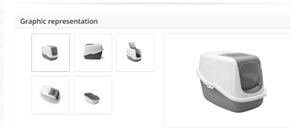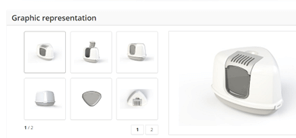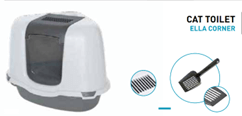
Belgium court considers design and copyright protection of cat litter trays
In this article we look at an interesting decision from the Belgian Community Design courts and the potential practical implications. The decision delves into complex issues including the relationship between design and copyright laws, and forum shopping. (Savic NV v Plana S Proizvodnja in Prodaja and Petsolutions NV, Case No. A/22/02872).
Factual background
Savic NV (“Savic“) manufactures plastic accessories and housing for pets and had registered two Registered Community designs (“RCD”) for cat litter trays, sold under the names ‘Nestor’ (nr. 002090365-0001) and ‘Nestor Corner’ (nr. 002472472-0002).
Slovenian company Plana S Proizvodnja in Prodaja (“Plana”) produced and distributed cat litter boxes named ‘Ella’ and ‘Ella Corner’. These were sold in Belgium by Petsolutions NV (“Petsolutions”), a wholesaler of pet supplies, sourcing its products from various suppliers including Plana.
Savic


Plana


Savic alleged that the ‘Ella’ and ‘Ella Corner’ products infringed its rights and initiated infringement proceedings in Brussels against both Plana and Petsolutions, seeking injunctive relief throughout the EU based on its RCDs. Savic further claimed that Plana’s products infringed its copyright in the litter boxes, and that their commercialisation impaired the rules on unfair commercial practices.
Court ruling
Forum
The Belgian court first had to decide on its jurisdiction over Savic’ claim for an EU-wide design injunction against the Belgian defendant Petsolutions and the Slovenian company Plana.
The court adopted a broad interpretation of Article 8.1 of the Brussels I Regulation (Regulation 1215/2012). Petsolutions disputed being a formal distributor of Plana’s. The court however found it sufficiently certain that Petsolutions purchased (at least part of) the allegedly infringing products from Plana. Consequently, relying on the principles set out in the CJEU Nintendo judgment (C-24/16 and C-25/16), the court established its EU-wide jurisdiction over both defendants based on the factual and legal connection between the claims against them.
Designs
On the merits, the primary defence of Plana and Petsolutions was a counterclaim for revocation of the asserted RCDs. They argued that the RCDs were invalid because they were solely dictated by the litter box’s technical function (Article 8, Community Design Regulation 6/2002) or due to a lack of novelty and individual character (Articles 4-6).
Although the court considered that technical/functional considerations did play an important role in the development of the RCDs, it found that they did not to fall foul of Article 8.1. Not all features of the designs were solely dictated e.g. use of contrasting colours and materials on the flip-top of the litter box, or the circular shaped, integrated handle.
However, the Court found that the Nestor RCD lacked the required individual character, finding that those features that are not technically determined were also present in prior designs. The Nestor Corner RCD was found to lack the required novelty.
Consequently, as both asserted RCD’s were invalidated, Savic’s design infringement claim was unfounded.
Copyright and unfair competition
The court also dismissed Savic’s claims of copyright infringement and unfair competition. It essentially denied copyright protection to the shape of the designs for the same reasons that led to revocation of the RCDs. Indeed, the court referred to the fact that the designs were largely dictated by technical function and lacked individual character/novelty, to conclude that the designs were also not or not sufficiently the result of the free and creative choices of their author and therefore not eligible for copyright protection.
Practical implications
The Belgian court’s liberal approach to its jurisdiction in this case may help design owners to take action against infringement of their design rights on an EU-wide basis, by bringing together companies in different EU member states before the Belgian court to seek a pan-European decision on infringement.
For that, of course, the design right needs to be valid. Here, the Brussels Court found the designs to be invalid (for lack of novelty and individual character). It examined their overall impression without taking into account those features it found to be solely determined by function. This is in line with relevant European case-law (Posts, T-231/21; Tinnus, T-574/19, Lego, T-515/19).
The claimant cumulated its design claims with a claim for copyright infringement but saw that claim rejected as well. The court found the product designs did not meet the requirement of “originality” by referring to its earlier findings of lack of novelty and individual character under the Community Design Regulation. However, under CJEU copyright case-law, the only relevant criterium is whether the author has expressed his creative ability in an original manner by making free and creative choices in such a way as to reflect his personality (Brompton, C-833/18). Novelty or individual character are not as such criteria for assessing eligibility for copyright protection.
It is hoped that more guidance may come from the CJEU on this issue. In a pending referral(Mio,C-580/23) the court has been asked which factors must be taken into account to determine if a work of applied art gives expression to the author’s free and creative choices.
Finally, the court’s rejection of the claimant’s claim of unfair competition, is in line with well-established case law. The mere copy of a given design (not protected by a valid intellectual property right) does not amount to an act contrary to honest trade practices. This is unless there are accompanying circumstances that as such constitute an act of unfair competition or the creation of confusion on the market.





